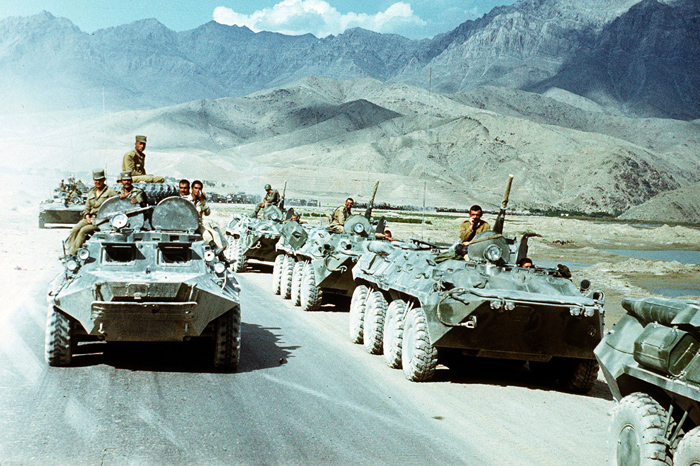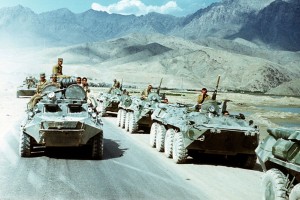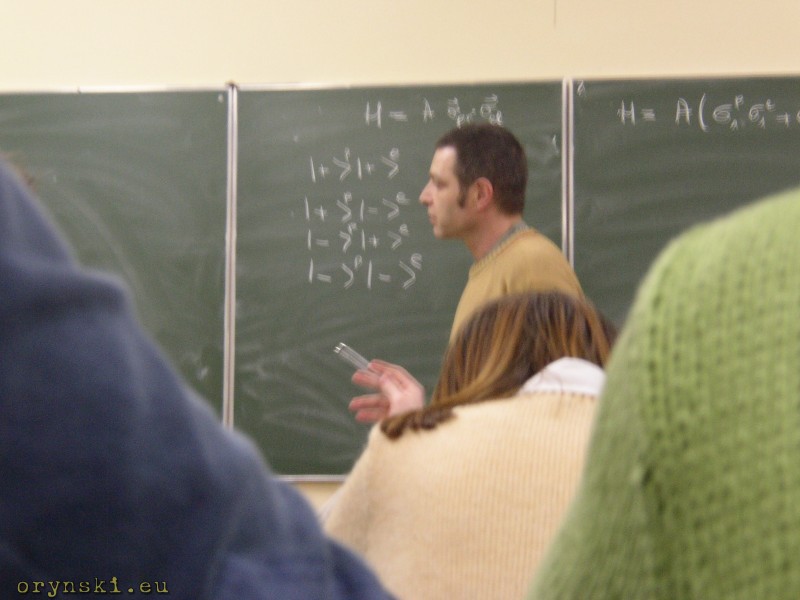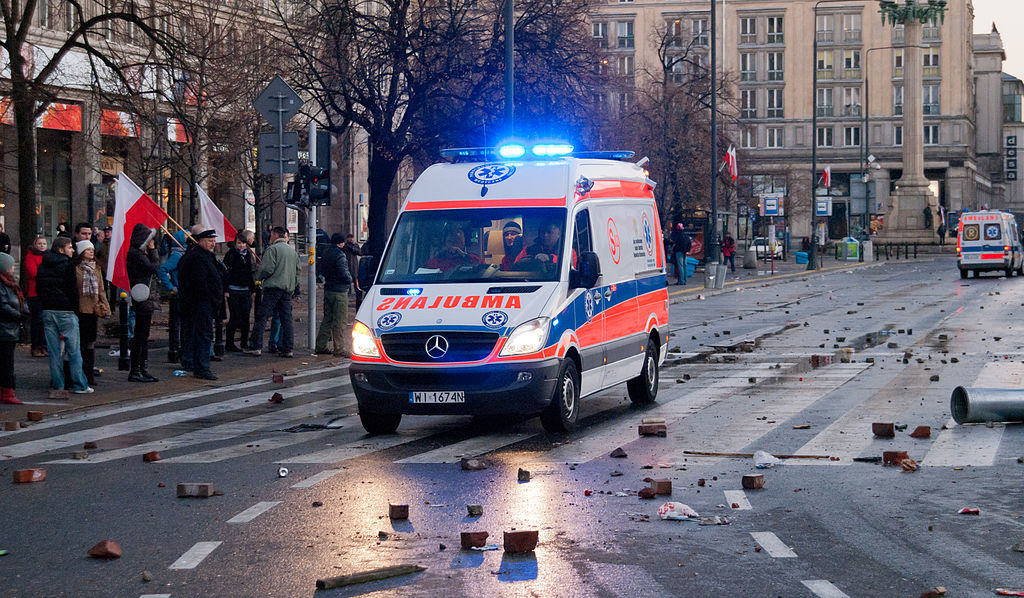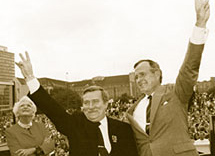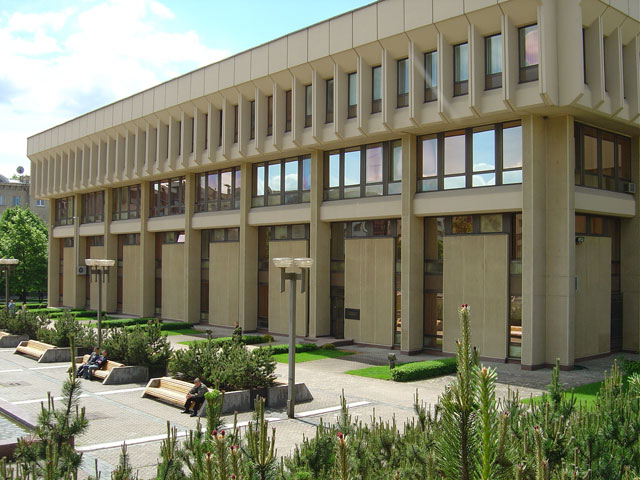Europe emerged from the Second World War as a divided continent. After stabilisation of the initial post-war chaos the Berlin Wall seemed to be unalterable, therefore neither West nor Soviet Union had a chance to gain anything on this field. Hence other areas had to become the board for the Cold War game for influence. Although until Stalin’s death in 1953 Soviet activity in the Third World was limited, Khrushchev recognized that the number of independent Third World states was increasing due to the post-World War II decolonialization1. The Soviets were happy to support the national liberation movement, as the will to break in from under colonial rule was seen as a liberation of working masses and therefore fitted into the Marxist-Leninism philosophy2. Second factor was that by supporting enemies of small pro-Western countries, West’s influence in strategic areas could have been confronted with a maximum local hostility3.
Cases of Soviet involvement in Ethiopia and Somalia shows that this second factor was often more important and new countries couldn’t have absolutely relied on Soviet friendship. In 1960 Somalia gained independence and from the very beginning refused to accept the existing borders as valid. There were fights between Ethiopia’s and Somali armies, which were lost by Somalia, as Ethiopia was equipped and armed by the USA and, therefore, stronger. Somalia requested $9000000 military aid from USA, but Kennedy rejected that as he did not wanted to jeopardise good relations with Ethiopia4. USA wasn’t kind enough to unconditionally support Somalia, as the border issues still weren’t solved and good relations with Ethiopia were important to keep the US bases at the coast of the Red Sea, which allowed to control route to the Suez Canal. In November 1963 Somalia refused Western offer of military assistance because of “political conditions which accompanied it” and accepted Soviet arms’ offer, free of formal conditions5. After bloodless coup in 1969, power was vested in the 20-member Supreme Revolutionary Council (SRC), which pursued a course of “scientific socialism” and in 1974 Somalia and the Soviet Union concluded a treaty of friendship and cooperation6. In the meantime, revolution in Ethiopia broke out and as Moscow saw it as a liberation of the working people when Haile Selassie was deposed in September 1974, the Soviet Union expressed satisfaction as the Emperor and his government were “serving as a conductors of imperialist influence”7. After the revolution Soviets worked to tighten the relations with the new Ethiopian government but at the same time Somalia, thanks to the Soviet support, became the 4th most armed country in black Africa (Ethiopia was 3rd )8. Around 1977 numerous internal events in both countries caused the Somalian-Ethopian tensions to change into an open conflict. Soviets’ attemps to calm down the situation failed and Somalia started a full-scale military operation in Ogaden. As a result, Soviets had to opt for one side of the conflict and they chose Ethiopia9. Russians calculated that Ethiopia was closer to the Middle East, was controlling entry to the Red Sea, had a population of about 40 000 000 people and a bigger army. The things came to such a point that Soviet military advisors were fighting on the both sides of the conflict, as USSR didn’t break off with Somalia officially yet, while they were already in Ethiopia10. Somalia, after it lost Soviet support, started to seek help on the West while still trying to patch the things up with USSR11, but in 1978 Soviets started official military intervention and airlifted personnel and military equipment from USSR and Cuba to Ethiopia12. As a result undersupplied and over-gunned Somalia lost the war. In just one year, Soviet policy in the Horn had complete somersault.
The Horn of Africa was an area of great importance as it was close to the Middle East, which was the central concern of Moscow’s foreign policy. The Middle East was close to the Soviet Union borders and was considered as a possible threat to Soviet control over waterways joining Europe, Asia, and North Africa. Oil deposit in this area was also an important factor. The main Soviet goal in the region had been to reduce British and, more recently, United States’ influence13. Apart of an open involvement of Soviet Union in the politics in region, Soviets tried to gain some influence by undercover support of the movements which were against American allies – such as KGB support for Palestinian and other Middle-Eastern terrorists when Israel’s close relationship with US became inconvenient for Soviet Union14. Therefore, Western powers were often quick to see all rebellions against colonial rule as a Moscow-inspired movements – for instance French inability to accept that the Front de Libération Nationale was indeed anti-French Algerian revolt not inspired by Moscow15.
Some countries instead of depend only on Soviet (or Western) help, managed to juggle their political relations with both main players of the Cold War and other countries, and managed to extort concession equally from all the competing powers. Such ability helped Indonesia, which existed at the crossing of different conflicts16. An example for the Middle-Eastern region is Turkey, which was induced to join NATO in 1952 by Soviet claims to its territory, but in 1960s relations improved and later Turkey benefited from the largest program of Soviet aid to any non-communist Third World state. Turkey continued a delicate balancing act between security cooperation within NATO and good relations with the Soviet Union till the end of 1980s17.
Apart from the Middle East, USSR was trying to gain some influence in other parts of the world. A cordial relationship with India that began in the 1950s represents one of the most successful relationships18. On the other side, Latin America was treated in Soviet Union as the United States sphere of influence. Soviet activities were limited to diplomacy, trade, culture and propaganda actions. The only state to purchase sizable quantities of arms from the USSR was Peru. The new era began there in 1959 when Fidel Castro, after overthrowing Cuba’s dictator, transformed the island into a communist state and developed very close ties with the Soviet Union. By 1961 Cuba became first “fraternal party state” for Soviet Union in the Western Hemisphere19. Soon both countries agreed to install Soviet missile installations at the Islands, which was of obvious strategic importance for Moscow but also for Havana, as it provided safety from another American-inspired attacks such as the one in Bay of The Pigs. Finally, the rockets were removed from the island, but Cuba gained assurance that United States would not invade the island20.
As US noticed that Soviet Union acted still more and more boldly it started to be afraid of Soviet influence spreading over the world. The so-called “domino effect”, theory of president Eisenhower, stated that after one country in a region came under the influence of communism, the surrounding countries would follow like domino bricks21. Acting on the basis of that theory, US decided to enter the Vietnam War to prevent “Asian domino from falling”. It was a big defeat for USA and it ended with a withdrawal of American Soldiers in 1973. This was a huge impact for American economy and in this year US had to free dollar’s exchange rate, which resulted in its slump22. In the same year, on the 6th of October more than 220 Egyptian warplanes flew over the Suez Canal and attacked Israel and the Ramadan War started23. OPEC countries, unhappy with new dollar prices, introduced an oil embargo on Western countries, using their support to Israel as a pretext. That caused a worldwide economical crisis24.
Worldwide support for Soviet orientated countries would not have been possible without participation of USSR’s satellite countries, as Soviet Union itself was quite isolated from the Western economy. Countries such as Poland, Hungary, Yugoslavia or Czechoslovakia had some kind of intermediate position in global market: they were buying technology from the West while exporting mainly their raw materials. In the same time, they were exporting manufactures of a lower quality to the Third World countries and importing raw materials from them25. During worldwide crisis planned economies of socialist states started to struggle to compete with Western or Asian market economies. That, in addiction to internal economical crisis, led to unrests among the people and in early 1980s first cracks in socialist’s world, such as the Solidarity movement in Poland, appeared. Soviet Union, despite economical crisis, was still getting involved in new places like Angola, which emerged as an independent country in 1975 and soon after that fell into a civil war between supported by the Soviets and Cuba Movimento Popular de Libertaçăo de Angola (Popular Movement for the Liberation of Angola) and the Uniăo Nacional para a Independęncia Total de Angola (National Union for the Total Independence of Angola), helped by US and South Africa26. Also when Soviet Union considered its position in Afghanistan imperilled, the Soviet leadership decided to invade the country in December 1979, which sucked USSR into a long war without any views to win it. Finally, Michail Gorbachev, who repeatedly called Afghanistan a “bleeding wound”27, became aware of seriousness of the situation and during late 1980s was increasingly trying to disengage Moscow’s foreign policy and foreign trade from theThird World and turned towards capitalist economy28. But the withdrawal from Afghanistan wasn’t complete until 198929 when other Soviet soldiers participated in fights in Angola up to 199030.
Soviet foreign policy over all this 45 years is characterised by some significant features. Moscow was avoiding direct involvement outside its sphere of influence and preferred indirect actions where possible, instead of an open confrontation with the US or their allies. Financial or material help was often at far more than reasonable level and in many cases after pumping a fortune into some country, Moscow gained little or nothing or, like in the case of Somalia, Soviets were just turning to another country. Yet political achievements should not be underestimated. While on the board of the Third World Soviet Union was managing relatively well, its failure to keep the pace with the West in other fields such as the Star Wars, the Arms Race or simply the economy, especially in the later part of discussed period, caused the downfall and, finally, a break-up of the empire.
In a certain sense, the Third World countries could benefit from this Western-Soviet competition. As long as the main players of the Cold War were looking for allies, they also tried to help somehow their partners. It was mostly military help (which was also welcomed and not always good for the country, as it allowed it to join some wars) but other kinds of support should not be underestimated either.
1 ‘The Soviet Union and the Third World’ in Raymond E. Zickel (ed.) “Soviet Union – a country study” Federal Research Division, Library of Congress, Research Completed May 1989 http://www.country-data.com/cgi-bin/query/r-12683.html Accessed: 29 XI 2008
2 Galia Golan “The Soviet Union and National Liberation Movements in the Third World”, Boston-London-Syney-Wellington Unwin Hyman Ltd 1988
3 Uri Ra’anan “The USSR Arms the Third World”, Cambridge, Massachusets and London, MIT 1969
4 Robert G. Patman “The Soviet Union in the Horn of Africa”, Cambridge – New York – Port Chester – Melbourne – Sydney, Cambridge University Press 1990 p. 46
5 Patman, op.cit, p. 49 and next
6 US Department of State, http://www.state.gov/r/pa/ei/bgn/2863.htm Accessed: 3 XII 2008
7 Patman, op.cit. p. 162-164
8 Patman, op.cit. p. 180-181
9 Patman, op.cit. p. 200-205
10 Ryszard Kapuściński in: Witold Bereś, Krzystof Brunetko “Kapuściński: nie ogarniam świata” (PL: “Kapuściński: I don’t comprehend the world”), Warszawa, Świat Książki 2007. p.72
11 Patman op.cit p. 216-218
12 Patman op.cit. p. 228
13 ‘The Middle East and North Africa’ in Raymond E. Zickel (ed.) “Soviet Union – a country study” Federal Research Division, Library of Congress, Research Completed May 1989
http://www.country-data.com/cgi-bin/query/r-12684.html Accessed: 29 XI 2008
14 Christoper Andrew, Vasili Mitrokhin, “The World was going our way – The KGB and the battle for the Third World”, New York, Basic Books 2005, chapter 13
15 Andrew, Mitrokhin, op.cit p. 431
16 Uri Ra’anan, op.cit. Part II
17 ‘Turkey’ in Raymond E. Zickel (ed.) “Soviet Union – a country study” Federal Research Division, Library of Congress, Research Completed May 1989
http://www.country-data.com/cgi-bin/query/r-12685.html Accessed: 29 XI 2008
18 ‘India’ in Raymond E. Zickel (ed.) “Soviet Union – a country study” Federal Research Division, Library of Congress, Research Completed May 1989
http://www.country-data.com/cgi-bin/query/r-12690.html Accessed: 29 XI 2008
19 ‘Central and South America’ in Raymond E. Zickel (ed.) “Soviet Union – a country study” Federal Research Division, Library of Congress, Research Completed May 1989
http://www.country-data.com/cgi-bin/query/r-12696.html Accessed: 29 XI 2008
20 ‘Cold War: Cuban missile crisis’ from Revelations from the Russian Archives exhibit in Library of Congress (01/04/96) http://www.loc.gov/exhibits/archives/colc.html Accessed: 29 XI 2008
21 Public Papers of the Presidents Dwight D. Eisenhower, 1954, p. 381- 390
http://coursesa.matrix.msu.edu/~hst306/documents/domino.html Accessed 9 XII 2008
22 Eugeniusz Gostomski, ‘Dolar międzynarodowy’ (PL: ‘International dolar”) in Bankier.pl
http://www.bankier.pl/wiadomosc/Dolar-miedzynarodowy-1556421.html Accessed 9 XII 2008
23 ‘The will to win’ in Al-Ahram Weekly, Issue No.398, 8 – 14 October 1998
http://weekly.ahram.org.eg/1998/398/october.htm Accessed 9 XII 2008
24Wojciech Morawski ‘Historia Finansowa XX wieku (1970-1979)’ (PL: ‘Financial History of 20th century (1970-1979)’) http://www.gazetabankowa.pl/pl/dokumenty/Historia1970_1979 Accessed 9 XII 2008
25 André Gunder Frank ‘The Socialist Countries in the World Economy: The East-South Dimension’ in
Brigitte H. Schulz, William W. Hansen (ed.) “The Soviet Bloc and the Third World” Boulder, San Francisco & London, Westview Press 1989 p. 10-12
26 Peter Vanneman “Soviet strategy in southern Africa” Stanford, Hoover Institution Press 1990 p.57
27 ‘Afganistan’ in Raymond E. Zickel (ed.) “Soviet Union – a country study” Federal Research Division, Library of Congress, Research Completed May 1989
http://www.country-data.com/cgi-bin/query/r-12689.html Accessed 29 XI 2008
28Frank, op.cit p. 23
29 ‘Afganistan’ in Raymond E. Zickel (ed.) “Soviet Union – a country study” Federal Research Division, Library of Congress, Research Completed May 1989
http://www.country-data.com/cgi-bin/query/r-12689.html Accessed 29 XI 2008
30Frank, op.cit p. 23
Photo: “Evstafiev-afghan-apc-passes-russian” by Mikhail Evstafiev – Own work. Licensed under CC BY-SA 2.5 via Wikimedia Commons.

